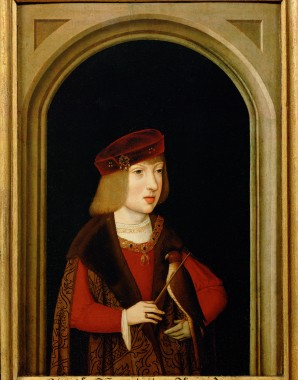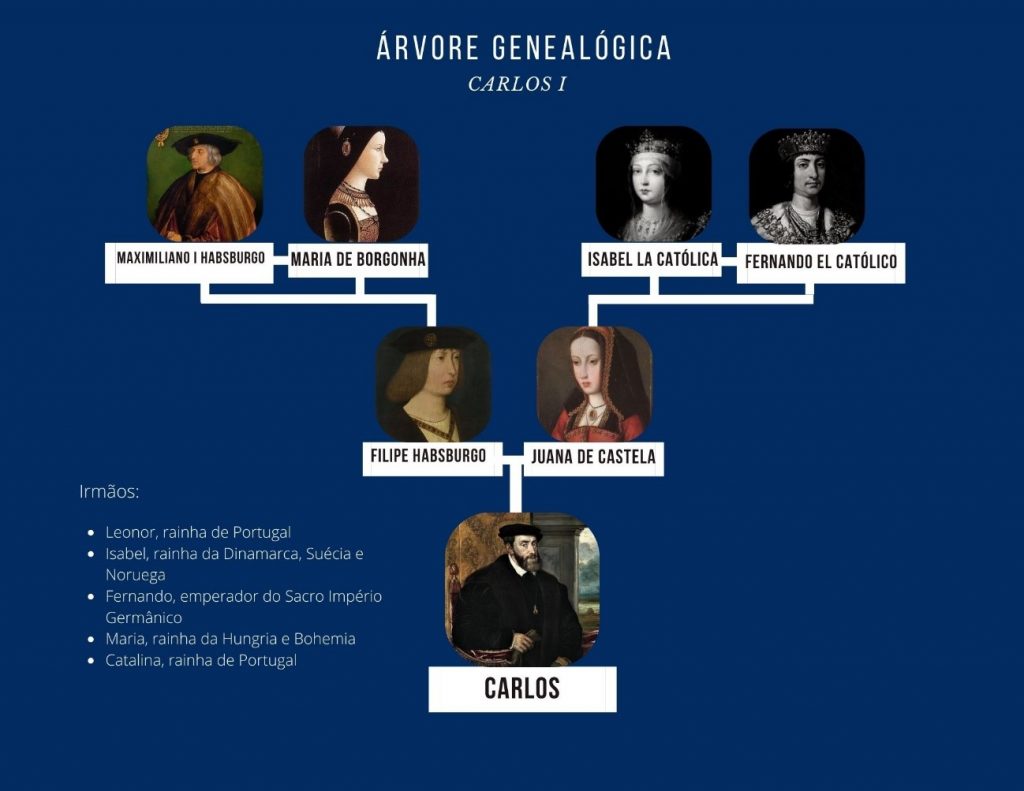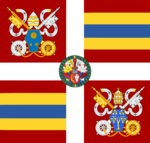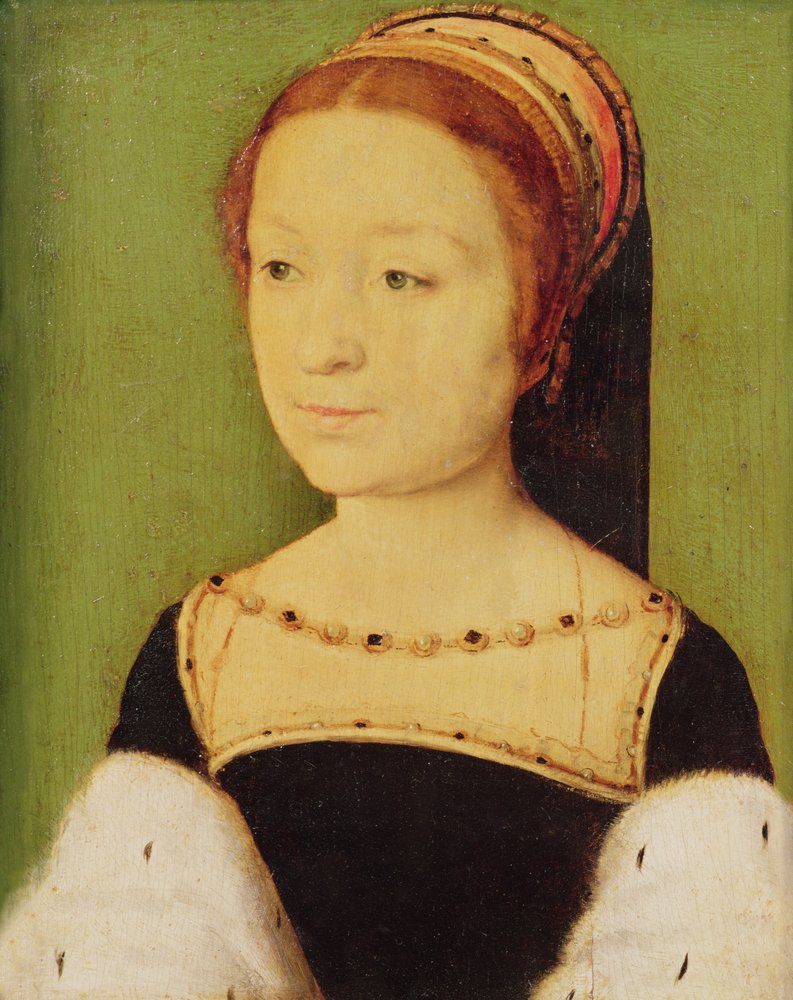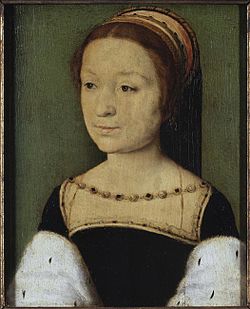|
|
General: EMPEROR CHARLES V (LETTER V=DA VINCI CODE) MASTER OF THE LEGEND OF MAGDALENE?
Triar un altre plafó de missatges |
|
|
https://www.habsburger.net/en/media/emperor-charles-v-age-seven |
|
|
|
|
María Magdalena de Austria
María Magdalena de Habsburgo y Wittelsbach (Graz, 7 de octubre de 1589-Padua, 1 de noviembre de 1631) fue la esposa de Cosme II de Médici, gran duque de Toscana.
Era hija de Carlos II de Estiria, archiduque de Austria, y de María Ana de Baviera. El matrimonio con el gran duque tuvo lugar en 1608. Después de la prematura muerte de su marido, acaecida en 1621, se dedicó junto a su suegra, Cristina de Lorena, a la educación de sus hijos, en particular del futuro gran duque Fernando II. Obtuvo además como herencia el gobierno de la ciudad de San Miniato hasta su muerte y no paró hasta que la pequeña ciudad se convirtió en diócesis.
Se interesó por la ciencia y procuró a sus hijos una gran educación, eligiendo como preceptores a algunos científicos discípulos de Galileo Galilei.
|
|
|
|
|
CARLOS I, JUANA “LA LOCA” Y FELIPE “EL HERMOSO”
PUBLIC DOMAIN
Desde 1536, se acuñaron en la Nueva España las primeras monedas por orden del Rey Carlos I. Eran de 4 reales con la inscripción “Carlos y Juana reyes”, porque fueron emitidas por él, supuestamente con apoyo de su madre la reina Juana I de Castilla, apodada “La Loca” porque perdió la razón a causa de los celos y la muerte de su marido Felipe “El Hermoso”. Estas monedas y las de 8 reales tenían símbolos que luego adoptaría el dólar americano.
HÉRCULES Y EL SÍMBOLO DEL DÓLAR
PUBLIC DOMAIN
A estas monedas les fueron grabados dos mundos y una corona, que simbolizaba el reinado español dividido por el mar, con dos columnas de Hércules, mitológicamente ubicadas en el Estrecho de Gibraltar, que según los griegos era el límite del mundo. En ambas columnas había dos banderines con las palabras “Plus Ultra” (Más Allá) que serpenteaban en forma de S. De ahí se cree que nació la “S” cruzada por dos barras verticales, que se convertiría en el símbolo del dólar.
EL NACIMIENTO DE LA PALABRA “DÓLAR”
GETTY IMAGES
Estas monedas que Carlos I ordenó acuñar eran similares a las que se fabricaban en Europa con el nombre de thaler, una abreviación de Joachimsthaler, una mina en la ciudad de Bohemia, hoy República Checa, pero en ese entonces territorio conquistado por España. Varios países la utilizaron, refiriéndose a ella como daler, daalder o tallero. Dollar fue la versión del nombre y la moneda adoptadas por los colonos británicos de América del Norte por no ser una moneda usada en Inglaterra.
MONEDAS CON EL ROSTRO DE WASHINGTON
PUBLIC DOMAIN
Luego del surgimiento y eventual uso de la libra esterlina, los peniques y chelines acuñados por Massachusetts en 1652, muchos monederos independientes acuñaron entre 1783 y 1792 diversas piezas, siendo las más populares las que traían grabada la imagen del presidente George Washington, a la usanza inglesa de poner a sus reyes en sus monedas. De estas se conocen más de 20 variedades, sobre todo centavos de cobre y plata.
LOS PRIMEROS DÓLARES DE PELO SUELTO
ISTOCK
El Congreso de Estados Unidos fundó en 1792 el United States Mint en Filadelfia, donde se emitió el primer dólar americano a iniciativa del presidente Thomas Jefferson, quien propuso que esta moneda fuera una unidad estándar de dinero. Así fue que se acuñaron piezas de plata de medio centavo, 10 centavos, un cuarto de dólar, medio dólar y un dólar, con la imagen grabada de una mujer de pelo suelto que representaba a la libertad.
https://www.aarp.org/espanol/dinero/creditos-y-deuda/info-2015/historia-dolar-fotos.html |
|
|
|
|
¼ Dollar "Isabella Quarter" Columbian Exposition Commemorative
Características
https://es.numista.com/catalogue/pieces6695.html
|
|
|
|
|
The Sack of Rome, then part of the Papal States, followed the capture of Rome on 6 May 1527 by the mutinous troops of Charles V, Holy Roman Emperor, during the War of the League of Cognac. Charles V only intended to threaten military action to make Pope Clement VII come to his terms. However, most of the Imperial army (14,000 Germans, including Lutherans, 6,000 Spaniards and some Italians) were largely unpaid. Despite being ordered not to storm the city, they broke into the scarcely defended city and began looting, killing, and holding citizens for ransom without any restraint.[3] Clement VII took refuge in Castel Sant'Angelo after the Swiss Guard were annihilated in a delaying rear guard action; he remained there until a ransom was paid to the pillagers.
Benvenuto Cellini, eyewitness to the events, described the sack in his works. It was not until February 1528 that the spread of a plague and the approach of the League forces under Odet de Foix forced the army to withdraw towards Naples from the city. Rome's population had dropped from 55,000 to 10,000 due to the atrocities, famine, an outbreak of plague, and flight from the city. The subsequent loss of the League army during the Siege of Naples secured a victory in the War of the League of Cognac for Charles V. The Emperor denied responsibility for the sack and came to terms again with Clement VII. On the other hand, the Sack of Rome further exacerbated religious hatred and antagonism between Catholics and Lutherans.
The growing power of the King of Spain and Holy Roman Emperor Charles V alarmed Pope Clement VII, who perceived Charles as a threat to the papal power. Clement VII formed an alliance with Charles V's arch-enemy, King Francis I of France, which came to be known as the League of Cognac.[4]
Apart from the Pope and the King of France, the League also included the Duchy of Milan, the Republic of Venice, the Republic of Genoa, and the Florence of the Medici. The League began hostilities in 1526 by attacking the Republic of Siena, but the undertaking proved to be a failure and revealed the weakness of the troops at the Pope's disposal.[5]
The Imperial Army defeated the French army, but funds were not available to pay the soldiers. The 34,000 Imperial troops mutinied and forced their commander, Duke Charles III of Bourbon, to lead them towards Rome, which was an easy target for pillaging due to the unstable political landscape at the time.[citation needed]
Aside from some 6,000 Spaniards under the Duke of Bourbon, the army included some 14,000 Landsknechte under Georg von Frundsberg; some Italian infantry led by Fabrizio Maramaldo, the powerful Italian cardinal Pompeo Colonna, and Luigi Gonzaga; and some cavalry under the command of Ferdinando Gonzaga and Philibert, Prince of Orange. Though Martin Luther himself was against attacking Rome and Pope Clement VII, some who considered themselves followers of Luther's Protestant movement viewed the papal capital as a target for religious reasons. Numerous outlaws, along with the League's deserters, joined the army during its march.[citation needed]
The Duke of Bourbon left Arezzo on 20 April 1527, taking advantage of chaos among the Venetians and their allies after a revolt broke out in Florence against Pope Clement VII's family, the Medici. His largely undisciplined troops sacked Acquapendente and San Lorenzo alle Grotte, and then occupied Viterbo and Ronciglione, reaching the walls of Rome on 5 May.[citation needed]
|
|
|
|
|
The growing power of the King of Spain and Holy Roman Emperor Charles V alarmed Pope Clement VII, who perceived Charles as a threat to the papal power. Clement VII formed an alliance with Charles V's arch-enemy, King Francis I of France, which came to be known as the League of Cognac.[4]
Apart from the Pope and the King of France, the League also included the Duchy of Milan, the Republic of Venice, the Republic of Genoa, and the Florence of the Medici. The League began hostilities in 1526 by attacking the Republic of Siena, but the undertaking proved to be a failure and revealed the weakness of the troops at the Pope's disposal.[5]
The Imperial Army defeated the French army, but funds were not available to pay the soldiers. The 34,000 Imperial troops mutinied and forced their commander, Duke Charles III of Bourbon, to lead them towards Rome, which was an easy target for pillaging due to the unstable political landscape at the time.[citation needed]
Aside from some 6,000 Spaniards under the Duke of Bourbon, the army included some 14,000 Landsknechte under Georg von Frundsberg; some Italian infantry led by Fabrizio Maramaldo, the powerful Italian cardinal Pompeo Colonna, and Luigi Gonzaga; and some cavalry under the command of Ferdinando Gonzaga and Philibert, Prince of Orange. Though Martin Luther himself was against attacking Rome and Pope Clement VII, some who considered themselves followers of Luther's Protestant movement viewed the papal capital as a target for religious reasons. Numerous outlaws, along with the League's deserters, joined the army during its march.[citation needed]
The Duke of Bourbon left Arezzo on 20 April 1527, taking advantage of chaos among the Venetians and their allies after a revolt broke out in Florence against Pope Clement VII's family, the Medici. His largely undisciplined troops sacked Acquapendente and San Lorenzo alle Grotte, and then occupied Viterbo and Ronciglione, reaching the walls of Rome on 5 May.[citation needed]
|
|
|
|
|
Pedro de Mendoza, adelantado del Río de la Plata (h. 1499-1537)
https://www2.ual.es/ideimand/pedro-de-mendoza-adelantado-del-rio-de-la-plata-h-1499-1537/ |
|
|
|
|
Male and Female symbols

Male symbol, Mars, blade

Military patches
Female symbol, Venus, chalice

|
|
|
|
|
Madeleine de France, Queen of Scotland, 1536
(Madeleine de France (1520-37) Queen of Scotland, 1536 )
|
https://www.meisterdrucke.us/fine-art-prints/Corneille-de-Lyon/80721/Madeleine-de-France,-Queen-of-Scotland,-1536.html
|
|
|
|
|
Madeleine of Valois
Madeleine of Valois (10 August 1520 – 7 July 1537) was a French princess who briefly became Queen of Scotland in 1537 as the first wife of King James V. The marriage was arranged in accordance with the Treaty of Rouen, and they were married at Notre-Dame de Paris in January 1537, despite French reservations over her failing health. Madeleine died in July 1537, only six months after the wedding and less than two months after arriving in Scotland, resulting in her nickname, the "Summer Queen".
 Madeleine (back right) with her mother and sisters, from the Book of Hours of Catherine de'Medici.
Madeleine was born at the Chteau de Saint-Germain-en-Laye, France, the fifth child and third daughter of King Francis I of France and Claude, Duchess of Brittany, herself the eldest daughter of King Louis XII of France and Anne, Duchess of Brittany.
She was frail from birth, and grew up in the warm and temperate Loire Valley region of France, rather than at Paris, as her father feared that the cold would destroy her delicate health. Together with her sister, Margaret, she was raised by her aunt, Marguerite de Navarre until her father remarried and his new wife, Eleanor of Austria, took them into her own household.[1] By her sixteenth birthday, she had contracted tuberculosis.[2]
Marriage negotiations
[edit]
Three years before Madeleine's birth, the Franco-Scottish Treaty of Rouen was made to bolster the Auld Alliance after Scotland's defeat at the Battle of Flodden. A marriage between a French princess and the Scottish King was one of its provisions.[3] In April 1530, John Stewart, Duke of Albany, was appointed commissioner to finalize the royal marriage between James V and Madeleine.[4] However, as Madeleine did not enjoy good health, another French bride, Mary of Bourbon, was proposed.[5]
James V sent his herald James Atkinhead to see Mary of Bourbon,[6] and a contract was made for James to marry her. King James travelled to France in 1536 to meet Mary of Bourbon, but smitten with the delicate Madeleine, he asked Francis I for her hand in marriage. Fearing the harsh climate of Scotland would prove fatal to his daughter's already failing health, Francis I initially refused to permit the marriage.[7]
James V met Francis I and the French royal household between Roanne and Lyon on 13 October.[8] He continued to press Francis I for Madeleine's hand, and despite his reservations and nagging fears, Francis I reluctantly granted permission to the marriage only after Madeleine made her interest in marrying James very obvious. The court moved down the Loire Valley to Amboise, and to the Chteau de Blois, and the marriage contract was signed on 26 November 1536.[9]
Wedding at Notre-Dame
[edit]
 Notre-Dame de Paris Notre-Dame de Paris and its environs, known as the Parvis, Jean Marot, 17th century
In preparation for the wedding, Francis I bought clothes and furnishings for Madeleine; jewels and gold chains were supplied by Regnault Danet, linen and cloths by Marie de Genevoise and Phillipe Savelon, clothes by the tailors Marceau Goursault and Charles Lacquait, veils by Jean Guesdon, and trimmings by Victor de Laval, who also made passementerie for a bed that Francis gave the couple. The goldsmith Thibault Hotman made silver plate for Madeleine.[10][11] The merchants of the royal "argenterie", René Tardif and Robert Fichepain supplied silks and woollen cloth.[12] A quantity of gold and silver trimmings for embroidering the clothes of Madeleine and her ladies were ordered from Baptiste Dalverge, a wire-drawer.[13] A platform walkway was constructed from the Bishop's Palace to Notre-Dame de Paris.[14]
After a Royal Entry into Paris on 31 December 1536,[15] they were married at Notre-Dame on 1 January 1537.[2] There was a banquet that night in the Great Hall of the Palais de la Cité.[16] Over the next two weeks there were further celebrations and tournaments at the Chteau de la Tournelle and Louvre.[17] The wedding festivities in 1537 were similar to those of 24 April 1558, for the wedding of Mary, Queen of Scots, and Francis, Dauphin of France.[18]
Francis I provided Madeleine with a generous dowry of 100,000 écu, and a further 30,000 francs settled on James V. According to the marriage contract made at Blois, Madeleine renounced her and any of her heirs' claims to the French throne. If James died first, Madeleine would retain for her lifetime assets including the Earldoms of Fife, Strathearn, Ross, and Orkney with Falkland Palace, Stirling Castle, and Dingwall Castle, with the Lordship of Galloway and Threave Castle.[19]
 Coat of arms of Madeleine of Valois as Queen consort of Scots
In February the couple moved to Chantilly, to Senlis and Compiègne, where James received the Papal gift of hat and sword.[20][21][22] They stayed two nights at the Chteau de La Roche-Guyon.[23] After months of festivities and celebrations, the couple left France for Scotland from Le Havre in May 1537. The French ships were commanded by Jacques de Fountaines, Sieur de Mormoulins.[24] On 15 May, English sailors sold fish to the Scottish and French fleet off Bamburgh Head.[25] Madeleine's health deteriorated even further, and she was very sick when the royal pair landed in Scotland. They arrived at Leith at 10 o'clock on Whitsun-eve, 19 May 1537.[26]
According to John Lesley the ships were laden with her possessions;
"besides the Quenes Hienes furnitour, hinginis, and appareill, quhilk wes schippit at Newheavin and careit in Scotland, was also in hir awin cumpanye, transportit with hir majestie in Scotland, mony costlye jewells and goldin wark, precious stanis, orient pearle, maist excellent of any sort that was in Europe, and mony coistly abilyeaments for hir body, with mekill silver wark of coistlye cupbordis, cowpis, & plaite."[27]
A list or inventory of wedding presents from Francis I also survives, including Arras tapestry, cloths of estate, rich beds, two cupboards of silver gilt plate, table carpets, and Persian carpets.[28][29] Francis I also gave James V three of the ships, the Salamander, Morsicher, and Great Unicorn.[30] Madeleine took up residence at Holyrood Palace on 21 May 1537.[31]
French household in Scotland
[edit]
The French courtiers who came with her to Scotland to form her household included; her former governess, Anne de Boissy Gouffier, Madame de Montreuil; Anne de Viergnon, Madame de Bren or Bron; Anne Le Maye; Marguerite de Vergondois her chamberer; Marion Truffaut, her nurse; her secretary, Jean de Langeac, Bishop of Limoges; master household, Jean de St Aubin; squires and cupbearers Charles de Marconnay and Charles du Merlier; the physician Master Partix; pages John Crammy and Pierre de Ronsard; furrier Gillan; butcher John Kenneth; barber Anthony.[32][33][34] A physician from Paris, Jacques Lecoq, set out later to join her in Scotland.[35]
Madeleine wrote to her father from Edinburgh on 8 June 1537 saying that she was better and her symptoms had diminished. James V had written to Francis I asking him to send the physician Master Francisco, and Madeleine wrote that he was now needed only to perfect her cure. She signed this letter "Magdalene de France".[36] However, a month later, on 7 July 1537, (a month before her 17th birthday), Madeleine, the so-called "Summer Queen" of Scots, died in her husband's arms at Holyrood Palace.[37]
James V wrote to Francis I informing him of his daughter's death.[38] He called Madeleine "my dear companion" – votre fille, ma trés chére compaigne.[39]
Queen Madeleine was interred in Holyrood Abbey in Edinburgh, next to King James II of Scotland. Black mourning clothes were worn at her funeral, and an order was sent to the merchants of Dundee to provide black cloth. Her household servants were provided with "dule gowns", and horses at the procession had black cloths and trappings.[40][41] The chapel at Holyrood Palace was draped with cloth from Milan.[42] The grave was desecrated by a mob in 1776 and her allegedly still beautiful head was stolen.[43]
One of her gentlewomen, Madame de Montrueil or Motrell, visited London on her way back to France. She said that Madeleine "had no good days after her arrival there (in Scotland), but always sickly with a catarrh which descended into her stomach, which was the cause of her death".[44]
An inventory made of the king's goods in 1542 includes some of her clothes, furnishings for her chapel, six stools for her gentlewomen to sit upon, and gold cups and other items made for her when she was a child.[45]
Madeleine's marriage and death were commemorated by the poet David Lyndsay's Deploration of Deith of Quene Magdalene; the poem describes the pageantry of the marriage in France and Scotland:
O Paris! Of all citeis principall!
Quhilk did resave our prince with laud and glorie,
Solempnitlie, throw arkis triumphall. [arkis = arches]
* * * * * *
Thou mycht have sene the preparatioun
Maid be the Thre Estaitis of Scotland
In everilk ciete, castell, toure, and town
* * * * * *
Thow saw makand rycht costlie scaffalding
Depaynted weill with gold and asure fyne
* * * * * *
Disagysit folkis, lyke creaturis devyne,
On ilk scaffold to play ane syndrie storie
Bot all in greiting turnit thow that glorie. [greiting = crying: thow = death][46]
Epitaphs in Latin were composed by the French writers Etienne Dolet, Nicolas Desfrenes, Jean Visagier, and an anonymous poet. Gilles Corrozet and Pierre de Ronsard wrote verses in French.[47]
Less than a year after her death, following negotiations completed by David Beaton, James V married the widowed Mary of Guise. She had attended his wedding to Madeleine, and perhaps her uncle, Jean, Cardinal of Lorraine, suggested her to Francis I as a bride for the Scottish king.[48] Twenty years later, listed amongst the treasures in Edinburgh Castle were two little gold cups, an agate basin, a jasper vase, and crystal jug given to Madeleine when she was a child in France.[49]
|
|
|
|
|


 
Pope Francis delivered a speech too progressive for Obama to give
Sep 24, 2015, 4:20 PM GMT-3
Pope Francis waves to the crowd from the Speakers Balcony at the US Capitol, September 24, 2015, in Washington, DC. Pool/Getty Images
If President Barack Obama had delivered the text of Pope Francis’s speech to Congress Thursday as a State of the Union address, he would have risked being denounced by Republicans as a socialist.
While most Republicans chose not to complain, and Democrats tried not to gloat, Francis’s speech to Congress was stunning in the breadth, depth, and conviction of its progressivism. That might not have been fully and immediately appreciated by everyone in the House chamber because the combination of Francis’s sotto voce delivery and his heavily accented English made it difficult, lawmakers said, to grasp everything he was saying.
But there was no mistaking his thrust. He made detailed arguments for openness to immigrants, addressing the human roots of climate change, closing the gap between the rich and the poor, and ending the death penalty — all of which invigorated the Democrats in the room.
“It was pretty progressive. He had a little right-to-life stuff in it,” Rep. James Clyburn, the third-ranking House Democrat, said as he cracked a smile thinking about how Republicans would receive the speech. “That’s enough for them.”
The pope isn’t going to change many hearts and minds in the badly divided Congress, lawmakers said, but the moment provided a brief respite from political warfare. Several presidential candidates, including Sens. Bernie Sanders, Lindsey Graham, Marco Rubio, and Ted Cruz, as well as Ben Carson, attended.
Rubio, a Roman Catholic, said in a brief interview that Francis “struck the right tone.” Sanders, a self-described socialist, seemed to like the content even more.
“Pope Francis is clearly one of the important religious and moral leaders not only in the world today but in modern history,” he said in a statement released after the speech. “He forces us to address some of the major issues facing humanity: war, income and wealth inequality, poverty, unemployment, greed, the death penalty and other issues that too many prefer to ignore.”
Democrats were eager enough to present Congress as united that they joined a Republican-led standing ovation when Francis told lawmakers of “our responsibility to protect and defend human life at every state of its development.” Several of them said it was out of respect for the pope. But there was another good reason: It strengthened the perception that the whole speech — most of which they liked — carried unifying themes.
Unity was good for Democrats because the speech favored their policies
Francis was interrupted a few times by whoops from the Democratic side of the chamber — by Steve Cohen, a Jewish Memphis Democrat who got excited about Francis’s mention of the Golden Rule; by New York’s Nydia Velázquez when he called for an end to the death penalty; and by Philadelphia Rep. Chaka Fattah when he mentioned his upcoming visit to that city. The Republicans in the room were a bit more staid. Cruz often appeared unmoved during moments when Rubio, who was sitting nearby, applauded. That was the case when Francis asked whether the greater opportunities sought by past generations of immigrants are “not what we want for our own children?”
It was a home crowd. Rep. Paul Gosar (R-AZ) had announced he would boycott the event over climate change, and there was a brief murmur when it became obvious that three conservative Catholic Supreme Court justices — Antonin Scalia, Samuel Alito, and Clarence Thomas — had not shown up. But it seemed that everyone in attendance just wanted to catch a glimpse of Francis and hear what he had to say.
Big-name guests filed into the public galleries above the House chamber long before the pope’s arrival: Former House Speaker Newt Gingrich, former Rep. Gabby Giffords, mega-donor Tom Steyer, and Carson. House members filled the seats in their chamber, followed by the Senate and four Supreme Court justices. At about a minute past 10 am, Francis strode down the center aisle of the House chamber, clad in his familiar white robe and skullcap.
Lawmakers, who had been admonished not to touch the pope, refrained from trying to shake his hand or pat his back. There was no rush to crowd him the way members of Congress try to get into pictures with the president during the annual State of the Union address. When he got to the end of the aisle, he quietly shook hands with Secretary of State John Kerry and then made his way to the rostrum.
Samantha Power, the US ambassador to the UN, pulled out a baby blue iPhone and began snapping pictures. Though she later took to Twitter to commemorate the moment, Power hadn’t posted any of her photos by midday.
For his part, Francis warmed up the audience by describing America as “the land of the free and the home of the brave.” He was slow to move into more politically charged territory but unimpeded when he did. There were 10 standing ovations after his initial greeting, and they were bipartisan.
Francis tackled tough issues at the heart of the US political debate and gently admonished lawmakers to build bridges
At times, Francis seemed to be speaking directly into the headlines and newscasts of the day.
Less than a week after Carson said that America shouldn’t elect a Muslim president, Francis warned that “a delicate balance is required to combat violence perpetrated in the name of a religion, an ideology or an economic system, while also safeguarding religious freedom, intellectual freedom and individual freedoms.”
As Republican presidential frontrunner Donald Trump promises to build a wall between Mexico and the US, and to prevent Syrian refugees from being admitted to America, Francis compared the current refugee crisis to the one that arose in World War II and said that “we the people of this continent are not fearful of foreigners, because most of us were once foreigners.” That drew a standing ovation. Rubio, who has shifted his emphasis on immigration reform over time, leaped to his feet.
And while Democrats continue to bask in this summer’s Supreme Court decision protecting same-sex marriage, the pope said he was concerned that “fundamental relationships are being called into question, as is the very basis of marriage and the family.” The issue that caused the biggest stir before the speech — climate change — factored prominently in Francis’s remarks. He spoke of the human roots of global warming and said, “I am convinced we can make a difference.”
But perhaps the most unexpected run in the speech was an admonishment as gentle as it was clear: Politics is about building bridges, not destroying them. Francis never mentioned the international nuclear nonproliferation deal with Iran by name or the gridlock in American politics, but he seemed to be speak to both matters.
“When countries which have been at odds resume the path of dialogue — a dialogue which may have been interrupted for the most legitimate of reasons — new opportunities open up for all,” he said. “A good political leader is one who, with the interests of all in mind, seizes the moment in a spirit of openness and pragmatism. A good political leader always opts to initiate processes rather than possessing spaces.”
Pennsylvania Republican Rep. Joe Pitts, speaking about the pope’s limited remarks on abortion and same-sex marriage, said he was displeased that Francis had been “unfortunately politically correct.”
For liberals, though, he was simply correct about politics.
https://www.vox.com/2015/9/24/9393731/pope-francis-speech-progressive-obama
|
|
|
 Primer Primer
 Anterior
9 a 23 de 23
Següent Anterior
9 a 23 de 23
Següent
 Darrer
Darrer

|
|
| |
|
|
©2025 - Gabitos - Tots els drets reservats | |
|
|






